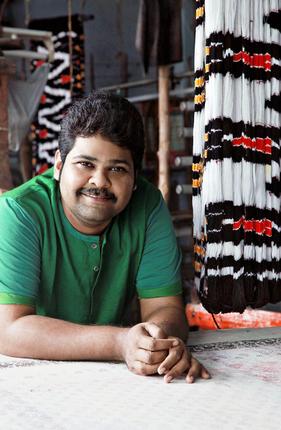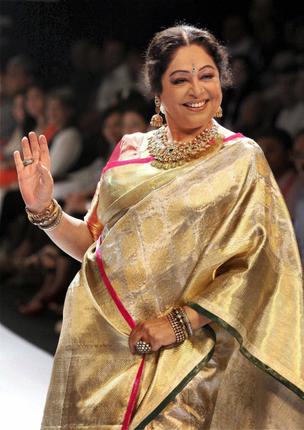Gaurang Shah
Gaurang Shah was lured by the weft and the warp long before the fashion industry turned its spotlight on handlooms
Revival is a word one often comes across in the fashion industry, in the context of ancient crafts, techniques and weaves. “It’s an overrated term,” laughs Gaurang Shah, the man who has been working with weavers for a decade. “When my brother and I were growing up, we didn’t know big words like ‘revival’. We grew up seeing our mom wearing the best of handlooms — Kanchi cottons, Bengal saris with kantha work, khadi and Uppada — and were drawn to textures born from the loom. Nine years ago when I thought of sourcing and selling saris, I could only think of handlooms,” he explains. Gaurang today liaises with weavers in 200 looms he established in villages in the outskirts of the city.
A day before he left for Dubai to participate in Numaish 2012 with his line Ardhangini featuring Kalamkari on Kanjeevarams, Gaurang says, “I’ve always been doing this — egging on my weavers to develop new and intricate patterns and challenging them with new textures. Now that I’ve participated in Lakme Fashion Week twice and the Lavera section of Berlin Fashion Week, people notice me more.”
A 30-second video shot by artist Laxman Aelay gives us a glimpse of the process of Jamdhani work on khadi. Gaurang is excited about showing this video and his line Ardhangini in Dubai. “Prominent Indian designers like Masaba Gupta and duo Shivan and Narresh are taking part in Numaish 2012. And I am told the audience predominantly consist of Indians, which is why I am confident of Ardhangini,” says Gaurang.
The designer has slightly tweaked the Ardhangini collection he showed early this year at Lakme Fashion Week to include Kota ghagras teamed with bandhini dupattas, garments with straight cuts with kalamkari work and saris. Gaurang is relatively a late bloomer in fashion week circuits, but he’s been in the field of handlooms for 13 years. The business that comes from his family store Indian Emporium remains his core strength while fashion weeks give him the added spotlight. “I’ve had loyal clientele for years. Some people have a tendency to go to designers in the spot light. Even they have returned to me after these fashion weeks. I guess the glamour quotient helps,” he laughs.
In 1962, his father established the store at Basheerbagh. “My brother and I used to go to the store after school and help dad with the stocks and manage the store. We got used to looking at fabrics, colours and textures. Apart from saris, we became famous as a matching centre for blouses. Those days, you didn’t have too many fabrics — only two by two and cotton,” he says.
Years later, when they moved to Begumpet and Gaurang and his brother joined the business, Gaurang introduced hand woven saris. “After my graduation, I studied interior designing for a couple of years. So I didn’t have formal training in fashion. I was interested in handlooms and didn’t know where to start,” he confesses.
He remembered the enviable collection of saris his mom had and set out to source the best. “I liked the Kanchi cotton saris with silk borders stocked at Usha’s store in Chennai, bought some of the saris and stocked a limited collection in our store,” he says. One thing led to another, as Gaurang got introduced to weavers who deal with Uppada, Kota and khadi through some of his loyal customers and friends. “I persuaded the weavers to give me something different. For example, I like the Mughal buttis of Agra and asked one of the weavers to replicate the pattern. I began drawing and sketching patterns for weavers, went to the looms and learnt the limitations under which they work and why they are reluctant to change,” he says. Gaurang could work around limitations but not the reluctance to change. “I don’t work with weavers who refuse to change with the times. There are occasions when a few weavers have sold off my designs elsewhere and I got to know later through my clients. At one point, in the fag end of 2009, I thought of closing down all this sari business,” he recalls.
Around that time, he met up with his friends in Mumbai. “One of my friends focussed on Maheshwari and another on printed Tussars in Pune and so on. As a group we used to hold annual exhibitions of woven saris in Mumbai and Delhi. We were bored with these exhibitions and the tedious process of carrying the load from one city to another. We thought of opening a permanent store for handlooms. We established Vaya (which means weaver) and Mumbai has been a receptive market for handlooms,” says Gaurang.
This made Gaurang reconsider his decision to stop working with weavers. “I had sold all my pending stock and wanted new designs and weaves,” he says. With the help of his master weaver, he reached out to more weavers and established looms. Apart from sourcing from weavers in different parts of the country, Gaurang helped set up 200 looms in the outskirts of Hyderabad, in which Uppadas, khadi, Banaras and Kota saris are woven.
Gaurang feels Hyderabad is the best place to be for a designer. “Customers always want something new, so you are on your toes trying to innovate with the weaves,” he says.
The saris from these looms had the edge over others with the weavers willing to do intricate Jamdhani work on khadi and Kota. Gaurang felt the need to broaden his base and applied to the Lakme Fashion Week, only to be rejected twice. “Handlooms are what I believe in and I wasn’t willing to budge. The third time, I got a slot for a small show. The second time around, it was a larger show where I featured Ardhangini and I managed to get Kirron Kher as the showstopper,” he says.
Kirron Kher displays a creation by Gaurang Shah. Photo:PTI
If the first collection for Lakme was dominated by tones of white, he explored the other end of the spectrum with bright vermillion and yellow hues in Ardhangini. “The collection was a hit. Even today people call and ask for the sari worn by Kirron Kher,” says Gaurang. The designer has no qualms in accepting that lobbying is an integral part of fashion weeks. He was awarded the best designer for Indian textiles and also participated in Lavera section of Berlin Fashion Week. “This posed new challenges. I had to design western silhouettes. We designed jump suits, off-shoulder dresses and anarkalis in khadi with Jamdhani work in floral patterns,” he says.
After creating high-end khadi saris with Jamdhani, he is now focusing on Jamdhani on Kota saris. “You get six yards of fabric and the possibilities are limitless,” he smiles.
source: http://www.TheHindu.com / Home> Life & Style> Fashion / by Sangeetha Devi Dundoo / Hyderabad, October 19th, 2012

